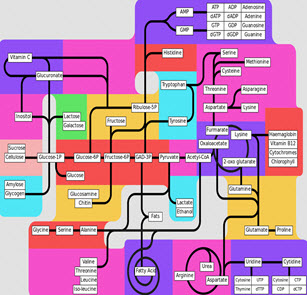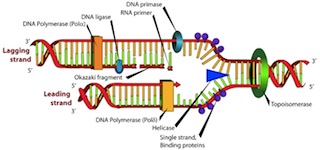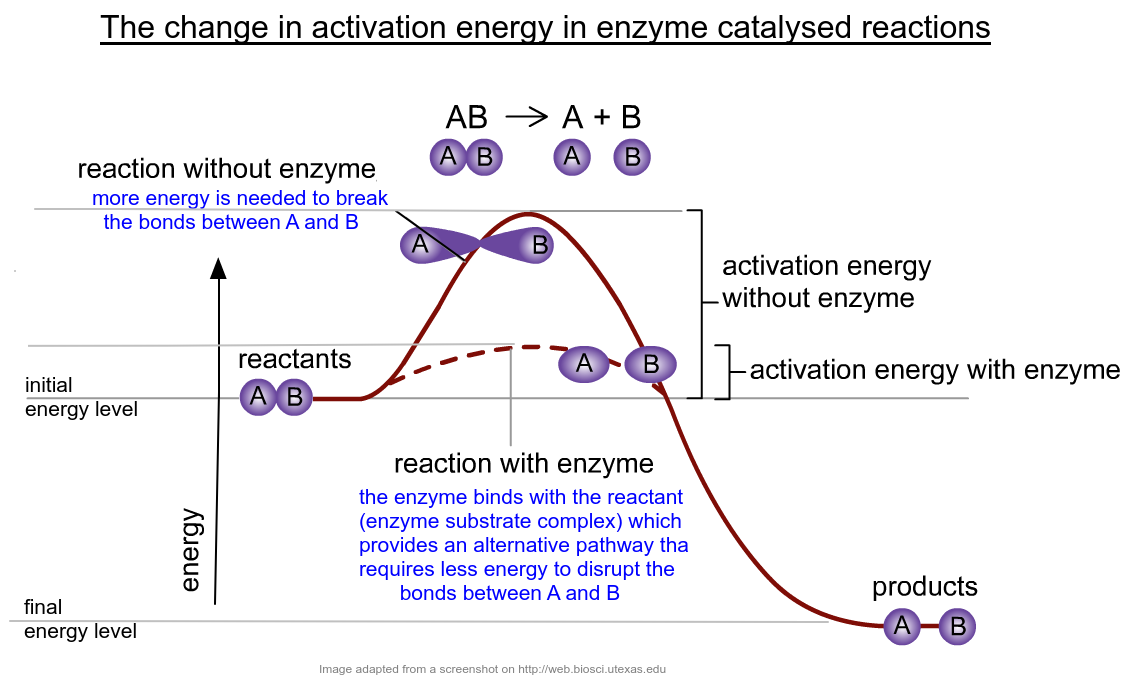Activation energy and enzyme pathways
 Students are introduced to a simple metabolic pathway consisting of a chain of enzyme-catalysed reactions leading to the Kreb's cycle which is a cycle of enzyme catalysed reactions. The method of enzymes to lower the activation energy is explained through an animation and there are some questions for students to answer.
Students are introduced to a simple metabolic pathway consisting of a chain of enzyme-catalysed reactions leading to the Kreb's cycle which is a cycle of enzyme catalysed reactions. The method of enzymes to lower the activation energy is explained through an animation and there are some questions for students to answer.
Lesson Description
Guiding Questions
- What do we mean by "metabolism"?
- When chemicals collide with more energy than the "activation energy" a reaction happens. How do enzymes change this activation energy to speed up reaction rates?
- If each enzyme is substrate specific how can enzymes perform complex reactions like DNA replication?
Activity 1 - What is metabolism?
Look at this diagram which summarise the enzyme catalysed reactions that break down alcohol into water and carbon dioxide.

..
Questions
Which enzyme has the product acetaldehyde?
Which enzyme has the substrate acetaldehyde?
How do the enzymes link together to form a metabolic pathway?
Model answers
Which enzyme has the product acetaldehyde?
alcohol dehydrogenase
Which enzyme has the substrate acetaldehyde?
acetaldehyde dehydrogenase
How do the enzymes link together to form a metabolic pathway?
The first enzyme produces the substrate of the second enzyme and so on.
Each enzyme catalyses one reaction in a chain of reactions.
Activity 2 - Enzymes and activation energy
Enzymes catalyse very many reactions in all living organisms. In this activity watch on of the simulations about activation energy and enzymes then answer the questions on ![]() the enzyme activation energy worksheet shown below.
the enzyme activation energy worksheet shown below.
This animated explanation of enzymes gives a short summary of how enzymes work.
Watch this animation of how enzymes lower the activation energy (select the "Overview")
If you prefer a Youtube version this is a good short explanation of ![]() Enzymes and activation energy
Enzymes and activation energy
This diagram summarises some of the main points. (click to enlarge)
Now answer the questions on the new ![]() Enzyme activation energy worksheet shown below.
Enzyme activation energy worksheet shown below.
Activity 3 - Extension - Browse a database of the complete human metabolism
Click this link to take you to the Reactome.org website. This is a free open source, peer reviewed database about human metabolism. Beware the complexity of this might blow your mind!
Here is a simple preview .... focused on glycolysis.
The fantastic animations in this short video from the PDB gives molecular details about the functioning of a specific enzyme. It is worth watching for the visualisations alone, but the descriptions of the reactions are not too complex for IB Biology students.
Teacher's notes
This is meant to be a simple introduction to metabolic pathways. The alcohol metabolism is important in the next topic so to introduce it here will help later.
Enzymes are covered in topic 2.6 and in the digestion section of topic 6. The details covered here are the extra HL details about activation energy. There are a couple of links included for revision.
The third activity is really just an invitation to browse a database on human metabolism.
There is a nice clear explanation of energy in chemical reactions including enzymes and activation energy in this video
There are model answers on the page -Activation energy - model answers see link in the left hand menu.

 IB Docs (2) Team
IB Docs (2) Team

